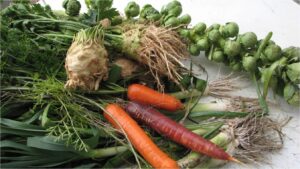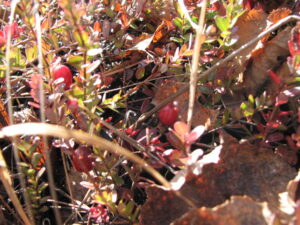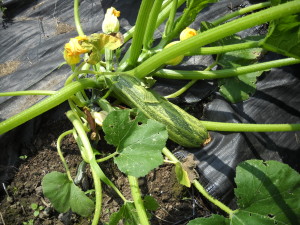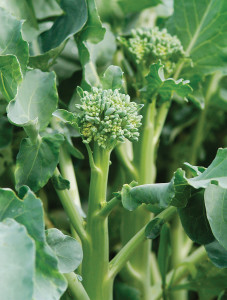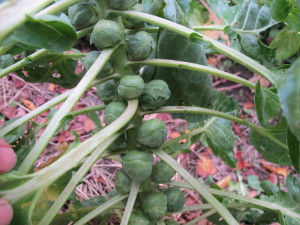Include Some Homegrown (or Local) Vegetables in You Holiday Feasts
So what will I have on my table for holiday feasts, both now and in December? Potatoes, for sure. They are easy to grow, very productive and store well. In a bed 50 feet long and three feet wide in full sun I can grow 50 pounds of potatoes – unless the blight that starved the Irish long ago comes along.
Brussels sprouts are very cold resistant and will be fine outdoors until late December – if the deer don’t find them. That’s right deer love Brussels sprouts, kale, broccoli and will munch them unless protected. I had no problem with deer this summer because of our dog, Rowan, who leaves scents around the property and advertises himself as a wolf. But deer are hungry now – very few nuts this year – so they have moved in to my late fall plantings, and are even eating the tops of my rutabagas.
I remember that many years ago there was a recall of fresh cranberries at Thanksgiving time due to some chemical that had been sprayed on them. Afterwards we all went back to eating cranberries and forgot about the scare. Now I try to get organic fruits and vegetables whenever possible, and grow my own organically – without the use of any chemicals.
Tips on Growing Vegetables, A to Z
It’s time to start thinking about the vegetable garden. We had frost recently, and will again, but this is a good time to think about what to plant. I can’t cover all plants I will grow – or have in the past – but I’d like to share a few tips on plants I love, starting with artichoke and going to zucchini.
Twenty years ago it was unheard of to grow artichokes in a New England garden. The first time I grew an artichoke from seed it developed into a huge plant, but didn’t start to produce “chokes” until cold weather came in the fall. So I built a little plastic-sheathed hoop house over it, and harvested my one and only artichoke in October – after snow! The local paper sent a reporter and a photographer.
Here’s what I’ve learned since that first effort: start early. I planted seeds March 3 this year in 6-packs and transplanted seedlings into bigger plastic pots in mid-April. Now the plants have 4 large leaves, and are ready to go to my cold basement (45 degrees) where I will set them up under lights on a timer, giving only 10 hours of light per day for the next10 days. This will fool those poor artichokes into thinking they have gone through a winter. Artichokes, you see, usually only produce in their second year. I’ll plant mine outside in early June. In California, artichokes are perennial – though I’ve never succeeded in overwintering them here.
Now locally grown artichokes are sold at farm and seedlings are sold, too, in case you haven’t started any. They will produce lovely foliage plants – and a few small artichokes. Some farms grow them in unheated greenhouses to stimulate them to produce their first year.
“B” is for beans. There are many varieties; all can be placed in one of two categories: bush beans or pole beans. Bush beans produce a nice yield of beans over a 3 to 4 week period, and are done. Pole beans, once they start producing, will continue to produce some beans until fall – if you keep picking them. Not only that, pole beans are better for casual gardeners, as many varieties still are yummy even if the beans are not picked on time and get large. Bush beans that get large, get woody. My favorite pole bean is ‘Kwintus’ from Cook’s Garden Seeds. ‘Kentucky Wonder’ is also great, and available everywhere.
Beans are legumes, and have nodules in their roots that can harbor nitrogen-fixing bacteria. These bacteria take nitrogen from the atmosphere and fix it in the soil – transforming it into nitrogen useable by plants. Free fertilizer, if you will. You can buy a packet of inoculant at garden centers. Wet your beans at planting time, then sprinkle the inoculant on the beans, and plant. A packet of inoculant will do a lot of beans, but won’t work next year, so share your leftovers with another gardener. And if you don’t get any in time, you can sprinkle it over the soil and water it in.
“B” is also for broccoli. I start mine by seed, but it’s getting a bit late for that now if you want early broccoli. But it is plentiful at garden centers, and quite cold-tolerant once hardened off and well established. You can plant seeds outdoors by seed in mid-July for a fall crop.
My favorite broccoli substitutes are two relatives that don’t ever produce a big head, but are quick-growing and produce very numerous mini-heads, what we would call side-shoots on broccoli. One is called piracicaba, and is available from Hudson Valley Seed Library (www.seedlibrary.org). It’s actually a tropical broccoli, so does well in the heat so summer when many others are feeling wilted and sad.
The other is Happy Rich, a hybrid sold by Johnny’s Selected Seeds (www.johnnyseeds.com). Like piracicaba, it has a lovely flavor – and you can eat the leaves and stems if you are so inclined. It produces all summer and well into the fall.
The last of the “B” vegetables, for today, at least, is Brussels sprouts. This vegetable is not universally well loved – too many cooks and lunch counters over cook it, serving mushy sprouts. But they are wonderful if lightly steamed and served with butter or vinegar.
Some gardeners never get big Brussels sprouts because they let the plants grow taller and taller, putting all their energy into growing tall. So here is what you need to do: cut off the top of the plant in early September. Labor Day at 10 am, to be precise. Cut off the top 3 to 4 inches, which is where upward growth occurs. Then the plant will use its energy to create big sprouts.
Skipping forward to “Z” as promised, my favorite zucchini is one called ‘Romanesco’. It has a striped, ridged exterior and firm flesh that is very tasty. What’s wonderful about it is that, unlike many summer squash and other zucchini, the flesh is still tasty and usable even if the squash goes unnoticed and develops into a big fruit.
Romanesco zucchini plants are rarely found at garden centers, but seeds are readily available. Buy the seeds now, plant outdoors in June or early May indoors in 4-inch pots.
Sorry I skipped a few vegetables in this year’s tips, but there will be more in future columns. Meanwhile, I’m going outside to plant some carrots – they come after the “B’s”.
Read Henry’s blog at https://dailyuv.com/
Cold Weather Crops
At this time of year I eat one of the “three B’s” from my garden every day: broccoli, Brussels sprouts or kale. All right, don’t get on my case. I know kale doesn’t start with a “B”. But it’s a brassica, the family that contains those other two, plus cabbage, rutabagas, cauliflower, kohlrabi and more. All are good cold weather crops.
In addition to surviving frosts, all the brassicas are healthy foods with lots of Vitamin C, soluble fiber and compounds thought to prevent cancer (though that is a little controversial). What you may not know is that boiling brassicas removes most of those cancer-fighting compounds, but steaming them or cooking them in a microwave dos not. Three to four minutes of steaming will cook your brassica nicely, but not steal many nutrients. But the best way to eat them is raw.
There are many varieties of broccoli, almost all are excellent. Arcadia is one that has done well for me, and is very cold hardy. I talked to my friend Chaz Meyers of Cornish Flat, N.H., who I think of as Mr. Broccoli. He and his wife, Jill Johnson, grow about 50 plants every year, freezing it and eating it all year. He told me that ‘Packman’ is favorite, in part because it produces lots of side shoots. He also likes ‘Waltham’ and ‘Gotham’ varieties.
Chaz recommends cutting the primary head of broccoli on an angle so that the stem, which is often a bit hollow, does not hold water (which might promote rot). He also suggests, if the summer is dry, watering your broccoli well after cutting the big head. That keeps the plant healthy and promotes the development of side shoots.
I once planted a little vegetable garden for a woman who didn’t know much about gardening. I planted two broccoli plants that produced magnificent heads in July. She ate them, with glee, and then pulled out the plants. Yikes! I regretfully explained that the most productive part of the plant are all those little “side shoots” that come after the main head. That, like the Energizer Bunny, broccoli keeps on producing for months. I’m still eating side shoots from plants I put in back in June.
Although broccoli are known for having little green caterpillars on them, mine have not had any this year – or none that I’ve seen. Maybe I’ve eaten a few. The best solution to the green caterpillar problem is just to soak the broccoli in cold water with a little salt in it before cooking. They will float up.
I dare say that my Brussels sprouts are perfect right now. Each is the diameter of a quarter- or a half dollar – and unbothered by any pests or diseases. I eat some every night for dinner: a dozen is just the right sized serving for me, so my six plant will keep me eating them for weeks. Brassicas are very hold hardy, and Brussels sprouts and kale will survive temperatures down to 20 degrees – or even colder. Frost helps to sweeten up their flavors.
Deer don’t bother my garden until it gets cold. Then they look for my Brussels sprouts and kale and broccoli. Once they waited until the night of December 24 to eat my Brussels sprouts, though that might have been the reindeer, waiting while Santa was inside the house. I recently took some preventive measures. I covered my kale with a scrap of chicken wire that I just draped over my plants, and then I surrounded the Brussels sprouts with some four-foot chicken wire. The broccoli will have to fend for itself – I’ve run out of fencing.
Kale is the perfect vegetable to freeze. Unlike spinach, it doesn’t get soggy when frozen. It keeps its character. I blanch it for a minute in boiling water. That kills the aging enzymes that would make it turn old and woody after just a few months in the freezer. When I take it out, I drop it into a sink full of cold water, spin it dry in my salad spinner, pat it dry with a tea towel, and put it in freezer bags. I suck out the air in the bags with a drinking straw. The straw goes into a zipper bag that is 99% closed, and I suck out the air. I snap the bag shut as I pull out the straw, and it’s ready to go in the freezer.
I know people that are gaga about kale chips, dried kale that is salty and crispy, the health-nut food to substitute for potato chips. I recently tried making my own but I’m neutral about them. Here’s what I did: I stripped the leaves off the central stem, and tore the leaves into pieces and put them in a big bowl. I coated them with a garlic and olive oil solution (I used 3 cloves garlic and a few tablespoons of oil). I sprinkled pepper flakes or nutritional yeast on the leaves and tossed some more. I added salt, but not a lot.
Then I put some kale chips in the oven at 150 degrees for 2 hours with the convection fan blowing, others in a food dehydrator at 135 degrees for 2.5 hrs. Maybe I needed to use more salt or oil, but I was aiming for a health food. And this tasted like something a little too healthy. Oh well. They’re crispy, but they’re definitely not as good as potato chips. Darn!
Eating the brassicas from my garden at this time of year is a wonderful way to transition to winter. I have food in the freezer from the summer, and root crops stored in the cellar. But it feels great to walk to the garden with a knife and cut something fresh for dinner.
Henry Homeyer is a gardening educator, speaker and writer. Reach him at henry.homeyer@comcast.net.
Rudolph and the Brussels Sprouts
Being a gardener gives me a supply of fresh vegetables, gorgeous flowers and, occasionally, good stories to tell. One of my favorite holiday stories was the time Rudolph and Santa’s reindeer found the Brussels sprouts – on Christmas Eve.
Several years ago I left a couple of Brussels sprouts plants unpicked as we approached Christmas. Given that we’d had a warm fall and early winter that year, I had just never bothered harvesting them. I had a young visitor from Scotland for the holidays that year, and Brussels sprouts are a must in Scotland on Christmas day. But the deer – or, as I told her – the reindeer got them on the night of the 24th. Ah well, Santa’s helpers needed a special treat that night.
Even though Brussels sprouts and kale are very cold tolerant, I picked mine well before Christmas this year as there is a four-point buck that has been feeding in my garden. Sigh. And winter is a time when deer predation can be a serious problem for anything edible, including trees and shrubs. What’s a gardener to do?
The best solution is to fence the area where deer are a problem. An eight-foot fence is what most experts recommend. And if there is high “deer pressure” (meaning large numbers and little natural food), a single strand of wire another foot or two above the fence may be required.
Last summer I planted and tended a small vegetable garden for friends who spend their summers in Wales. They’d had trouble with deer in their flower gardens, so I put up a fence when I planted the veggie garden for them. It was just a tiny patch, and I was able to put something up for a very reasonable cost.
Here is what I did: I bought plastic netting of the kind used to cover berry bushes to keep birds from stealing all the fruit. I bought 5 eight-foot bamboo poles, each about an inch in diameter, and a piece of one-inch plastic pipe. At each corner of the garden I pushed a pole into the soil until it was firmly in place. I used plastic tie-wraps to attach the netting to the poles (you could use tape or string for this instead).
Essentially, I wrapped the garden with mesh to keep out the deer, attaching it to each bamboo pole in turn. But after encircling the garden I didn’t attach the mesh to the first pole – if I had, there wouldn’t be any way in. Instead I attached the fencing to a fifth pole, a removable one that was right next to the first one. When I needed to enter, I lifted the fifth pole and moved it away, opening one side of the garden. That side was only 6 or 8 feet wide.
The movable pole was easy to move because it fit into a short section of plastic pipe in the ground. I tied the last bamboo pole to the first pole that was right next to it, and which was firmly anchored in the ground. When I wanted to get in, I moved that 6-foot section of fencing away and dropped the bamboo pole into another short section of plastic pipe that was in the ground at an appropriate distance away. That way I never put the fencing on the ground where it was likely to snag on something.
I have another client with a number of yews (an evergreen shrub) that were formerly the salad bar of the neighborhood deer population – but only in the winter. In summer the deer never bothered the yew. So what did we do? Cover the bushes with burlap. That keeps the deer from eating them, and offers some winter protection from cold winds.
Deer repellents work, too. The one that I like best is called Bobbex. It repels deer with its awful smell. Apply it when stems (and leaves) are dry, and the temperature is above 35 degrees. It has a number of animal proteins derived from eggs, fish and other nasties. The odor is quite offensive, even to us, for the first day or two – but much longer for the deer. They don’t want to eat the plants you have sprayed. I’ve read that the odor evokes fear in them as they approach your yew or rhododendron. It is made from all natural ingredients (no factory-made chemicals) but you should not use it on food products.
Coyote urine is another repellent that I have used, and that has worked for me. Instead of spraying it on like Bobbex, you put it in little plastic bottles that have holes in the upper portions of the sides and cotton balls in the bottom. Add the urine, hang the container on a twig or post, and the odor will drift out, keeping deer away. But it means that coyotes have to be contained in a cement floor cage with a drain to collect their urine, which can’t be a nice life, so I don’t buy it anymore. Some folks hang bars of soap from trees, too, or human hair. Deer get used to these things a bit faster than Bobbex, I believe.
So if you have deer in your neighborhood, get ready for winter. I’m not a hunter but I joke about clobbering deer on the head with a 2-by-4. I’ve seen the buck that ate some of my garden and I ran at it, shouting and barking. But that scares the neighbors, too.
You may reach Henry by email at henry.homeyer@comcast.net. His gardening website is www.gardening-guy.com.




